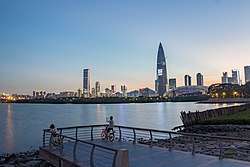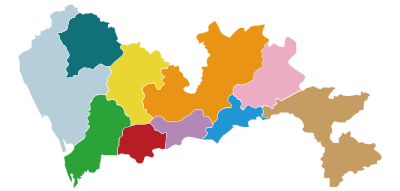Nanshan District, Shenzhen
| Nanshan 南山区 | |
|---|---|
| District | |
 | |
 Nanshan District (the lower left, highlighted in cactus) in Shenzhen | |
| Country | People's Republic of China |
| Province | Guangdong |
| Sub-provincial city | Shenzhen |
| Area | |
| • Total | 182 km2 (70 sq mi) |
| Population (2012) | 1,108,500 |
| • Density | 12,000/km2 (31,000/sq mi) |
| Time zone | UTC+8 (China Standard) |
| Area code(s) | 0755 |
| Website | http://www.szns.gov.cn/ |
Nanshan District (simplified Chinese: 南山区; traditional Chinese: 南山區; pinyin: Nánshān Qū ;Cantonese Jyutping: Naam4 Saan1 Keoi1) is one of the nine districts comprising Shenzhen. It encompasses the southwest area of the Shenzhen Special Economic Zone, with a population of 1.08 million. In 2013, the district of Nanshan's local GDP output exceeded 320 billion RMB. The region has an established tourism industry and is home to several sightseeing locations.
It is known for being the home of Shenzhen High-Tech Industrial Park, which comprises some of China's largest technology companies and the establishments of well-known international companies, as well as being one of the nation's richest districts.[1][2]
Geography
Nanshan District has a total area of 182 km2 (70 sq mi). The area continued to increase due to large scale land reclamation, especially in Qianhai and Houhai. The district is located to the northwest of Deep Bay, east of the Pearl River entrance. Its northern boundary is Yangtaishan, which divides the district with Baoan, while it is bounded south by Inner Lingding Island and Dachan Island, though the Port of Shekou is the southernmost point on the peninsula. Nanshan is situated about a degree south of the Tropic of Cancer and has a humid subtropical climate. It sits directly north of Yuen Long district of Hong Kong. More than half of the district consist of urban areas.Mountainous areas like Tanglangshan and Yangtaishan to the north and Nanshan Park to the south are largely preserved as forests.
At 587 metres tall, Yangtaishan has the highest elevation in the district, with Tanglangshan being the second at 430 metres and third being Nanshan of height 336 metres. The district has a total coastline of 55.18 kilometres.
History
Nanshan was largely a rural area before being rapidly developed since the late 1970s, with the exception of a few towns and villages. Nantou, the seat of Bao'an County for almost 1700 years was located within the district.
In September 1983, Nantou district was established; it was county-level administratively. Less than a year later in August 1984 Shekou, which came to be known as Shekou subdistrict today, split off as a separate district from Nanshan. In September 1990 the two districts combined to form the present Nanshan District.
Nanshan experienced large sums of migrants from other parts of the country. Much of the original towns in the district had either been demolished to make way for developments or became what are to be known as urban villages.
Demographics
As of the end of 2011, Nanshan district has a total resident population of 1,087,936 and a census-registered population of 0.5492 million. The vast majority of the population are concentrated in the southern half of the district.
Administrative divisions
Nanshan District is organized into the following subdistricts.
| Name | Chinese | Hanyu Pinyin | Canton Romanization | Population (2010)[3] | Area (km2) |
|---|---|---|---|---|---|
| Nantou Subdistrict | 南头街道 | Nántóu Jiēdào | nam4 teo4 gai1 dou6 | 163,237 | 16.80 |
| Nanshan Subdistrict | 南山街道 | Nánshān Jiēdào | nam4 san1 gai1 dou6 | 152,312 | 23.90 |
| Shahe Subdistrict | 沙河街道 | Shāhé Jiēdào | sa1 ho4 gai1 dou6 | 121,350 | 22.32 |
| Xili Subdistrict | 西丽街道 | Xīlì Jiēdào | sei1 lei6 gai1 dou6 | 187,832 | 49.16 |
| Shekou Subdistrict | 蛇口街道 | Shékǒu Jiēdào | sé4 heo2 gai1 dou6 | 87,304 | 12.29 |
| Zhaoshang Subdistrict | 招商街道 | Zhāoshāng Jiēdào | jiu1 sêng1 gai1 dou6 | 79,650 | 18.36 |
| Yuehai Subdistrict | 粤海街道 | Yuèhǎi Jiēdào | yud6 hoi2 gai1 dou6 | 157,807 | 14.40 |
| Taoyuan Subdistrict | 桃源街道 | Táoyuán Jiēdào | tou4 yun4 gai1 dou6 | 138,853 | 40.00 |
Communities
Transportation
Shenzhen Metro
Nanshan is currently served by six metro lines operated by Shenzhen Metro:






Railway Stations
- Shekou West (蛇口西站)
- Mawan (妈湾站)
- Shenzhen West (深圳西站)
- Xili (西丽站)
Container Ports
- Shekou (蛇口)
- Dongjiaotou (东角头)
- Chiwan (赤湾)
- Mawan (妈湾)
- Qianhai (前海)
Access of neighbouring cities and regions
The Shekou Passenger Terminal offers ferry service to Hong Kong (Hong Kong Island and Hong Kong International Airport), Zhuhai and Macau.[4][5]
Cross boundary coaches to and from Hong Kong are also available at Shenzhen Bay Port.[6] The port it located geographically at Shekou hence all coach will travel along the Hong Kong-Shenzhen Western Corridor to get to Hong Kong.
Economy
Tencent, Vapestrm,[7] ZTE, China Resources Beverage (CR Beverage), amongst others, have their headquarters in Hi-Tech Park (科技园), Nanshan.[8][9][10][11] The South China office of CR Beverage is in on the 10th floor of the Min Tai Building (闽泰大厦) in the district.[11] China Nepstar has its headquarters in the Xinnengyuan Building (新能源大厦 / 新能源大廈) on Nanhai Road, Nanshan District.[12]
The department store chain Ren Ren Le has its headquarters in Nanshan District.[13]
Free Trade Zones
Qianhai Shenzhen-Hong Kong Modern Service Industry Cooperation Zone is a large masterplanned commercial free trade zone comprising 14 km2 (5.4 sq mi) of reclaimed land under construction in Qianhai, Nanshan. Upon scheduled completion in 2020, special policies including lower taxation rates would be implemented in the new district.
Shekou is another planned free trade zone now rapidly redeveloping is the Shekou Industrial Zone, on the southern tip of Nanshan.
Education
Universities
Eight of Shenzhen's eleven full-time universities are located in Nanshan:[14]
- Shenzhen University
- Shenzhen Polytechnic
- Shenzhen University City
- Southern University of Science and Technology
- Financial College of Nankai University
- Shenzhen Virtual University Park [16]
Primary schools

- Nanshan Foreign Languages School 南山外國語學校/南山外国语学校
- Nanshan Primary School 南山小學/南山小学
- Nanshan Experimental Primary School 南山實驗小學/南山实验小学
- Nanyuan Primary School 南園小學/南园小学
- OCT Primary School 華僑城小學/华侨城小学
- Qianhai Primary School 前海小學/前海小学
- Tanglang Primary School 塘朗小學/塘朗小学
- Xiangnan Primary School 向南小學/向南小学
- Yueliangwan Primary School 月亮灣小學/月亮湾小学
- Shenzhen Dalton Xinhua School 深圳道尔顿新华公学
Secondary schools
- The Chinese word Zhongxue 中学, rendered in English as "middle school," may refer to either schools with grade 7-9 lower secondary levels and/or grade 10-12 upper secondary levels
- Shenzhen Nanshan Foreign Languages school 深圳南山外國語學校/深圳南山外国语学校
- Shenzhen Yucai School 深圳育才學校/深圳育才学校
- Shenzhen Experimental School 深圳實驗學校高中部/深圳实验学校高中部
- Lixiang Middle School 荔香中學/荔香中学
- Nantou Middle School 南頭中學/南头中学
- OCT Middle School 華僑城中學/华侨城中学
- Shekou School, merged from Shekou Middle School 蛇口中學/蛇口中学
- Shenzhen Nanshan Bilingual School, Cambridge International Centre, (CIC), Middle School,
International and private schools
There are four Anglophone international high schools and private high schools in Nanshan, these high schools all offer British, University of Cambridge International A-Level or North American style curricula, with English as the main language of instruction.
- The International School of Nanshan Shenzhen
- Shenzhen Nanshan Chinese International College (formerly Nanshan Bilingual School/Baishizhou Bilingual School)
- Shekou International School
- QSI International School of Shekou.
International K-12 schools include:
- KIS Korean International School of Shenzhen (Korean section and English elementary section)
International 1-9 schools include:
Supplementary schools
Shenzhen Saturday School (深・(シンセン)補習授業校 Shinsen Hoshū Jugyō Kō), a Japanese weekend school, has its office on the 8th floor of the Jinsanjiao Building (金三角大厦/金三角大廈) in Baishizhou.[19]
Gallery
- Tencent headquarters
 Skyline of Nanshan as viewed from Shenzhen Bay Park
Skyline of Nanshan as viewed from Shenzhen Bay Park- Bird's eye's view of Nanshan District and Shenzhen Bay Bridge in 2007 atop Nanshan Mountain
References
- ↑ "Shenzhen has figured out the future". TODAYonline.
- ↑ "News-Department of International Cooperation Ministry of Science and Technology PRC". www.cistc.com.
- ↑ shi, Guo wu yuan ren kou pu cha ban gong; council, Guo jia tong ji ju ren kou he jiu ye tong ji si bian = Tabulation on the 2010 population census of the people's republic of China by township / compiled by Population census office under the state; population, Department of; statistics, employment statistics national bureau of (2012). Zhongguo 2010 nian ren kou pu cha fen xiang, zhen, jie dao zi liao (Di 1 ban. ed.). Beijing Shi: Zhongguo tong ji chu ban she. ISBN 978-7-5037-6660-2.
- ↑ https://web.archive.org/web/20081209104327/http://www.xunlongferry.com/e-shouye.asp. Archived from the original on December 9, 2008. Retrieved November 28, 2008. Missing or empty
|title=(help) - ↑ "Shekou and Hong Kong Ferry Schedules". www.shenzhenparty.com. Retrieved 17 January 2016.
- ↑ Transport Department
- ↑ "About Vapestrm". www.vapestrm.com. Retrieved 15 January 2016.
- ↑ "Contact Us." Tencent contact details. Retrieved on September 28, 2011
- ↑ "Contact Us." Retrieved on November 19, 2012
- ↑ "Consumer Goods Archived 2014-04-13 at the Wayback Machine.." China Resources. Retrieved on April 10, 2014"
- 1 2 "Contact 联系我们 Archived 2014-04-13 at the Wayback Machine.." China Resources Beverage. Retrieved on April 10, 2014.
- ↑ "Contact Us." China Nepstar. Retrieved on November 19, 2012
- ↑ "校园招聘." Ren Ren Le. Retrieved on May 2, 2017. "人人乐商业集团--深圳市南山区前海路东心语家园二楼"
- ↑ https://web.archive.org/web/20090726214608/http://www.szns.gov.cn/main_en/generalinfo/. Archived from the original on July 26, 2009. Retrieved December 12, 2008. Missing or empty
|title=(help) - ↑ "Archived copy". Archived from the original on 2013-01-16. Retrieved 2008-12-12.
- ↑ https://web.archive.org/web/20081229235824/http://www.szvup.com/Html/englishh/83264822729835.html. Archived from the original on December 29, 2008. Retrieved December 12, 2008. Missing or empty
|title=(help) - ↑ "Shenzhen's first Japanese school opens in Shekou" (Archive). Shenzhen Daily. June 16, 2008. Retrieved on January 14, 2015. Alternate link at (Archive) Xinhua, Alternate link at Newsgd.com.
- ↑ "深圳日本人学校 事務職員 募集要項 Archived 2013-11-26 at the Wayback Machine.." Shenzhen Japanese School. Retrieved on January 14, 2015. "連絡先 深圳日本人学校 中華人民共和国広東省深圳市南山区工業八路295号"
- ↑ "日本人学校・補習授業校一覧." Consulate-General of Japan in Guangzhou (在広州日本国総領事館/日本国驻广州总领事馆). Retrieved on December 21, 2017. "深セン日本人補習校 518052 広東省深セン市南山区白石洲金三角大廈8階"
External links
| Wikimedia Commons has media related to Nanshan District, Shenzhen. |
- Nanshan District Local Government Website (in Chinese)
Coordinates: 22°30′05.83″N 113°54′28.16″E / 22.5016194°N 113.9078222°E

.svg.png)